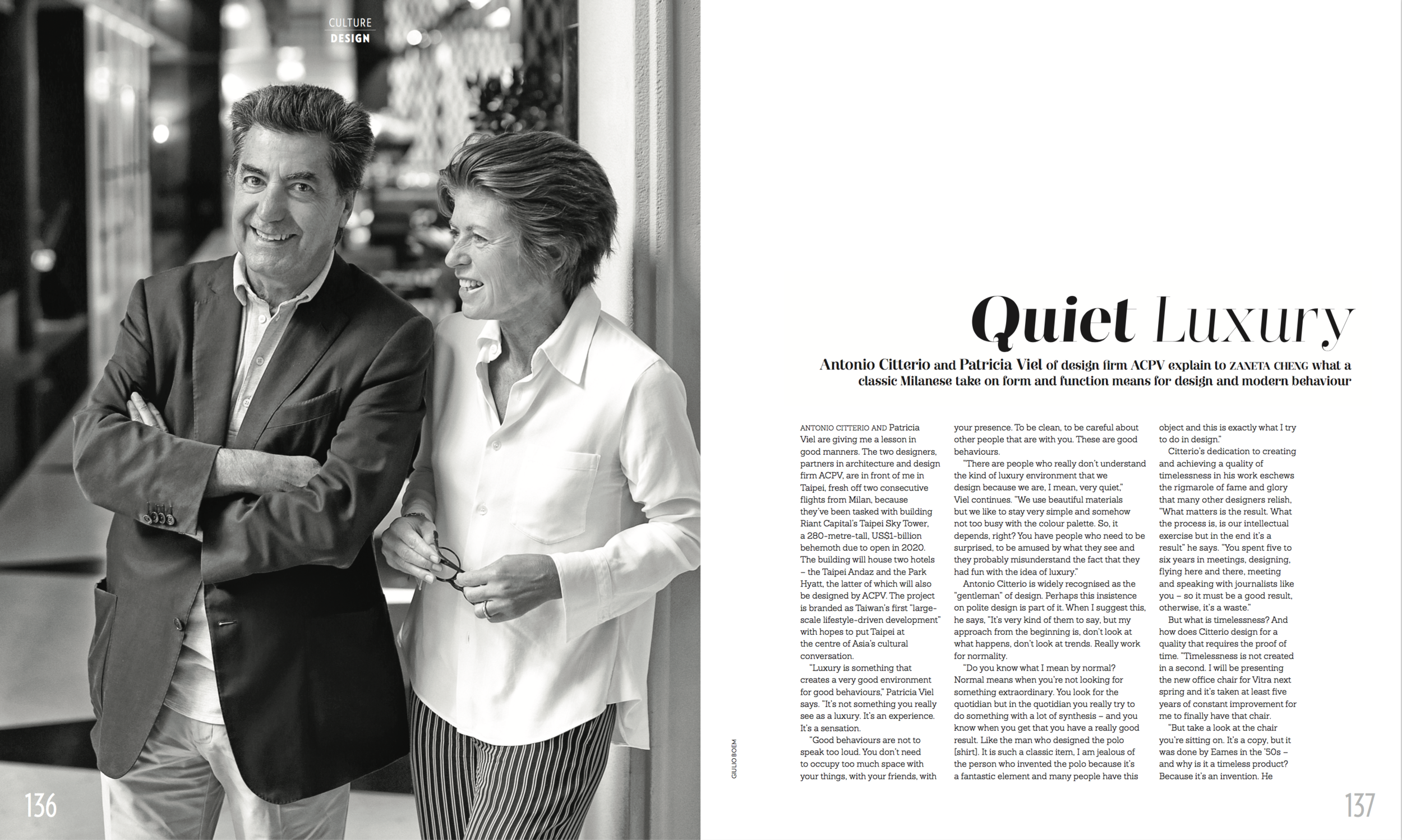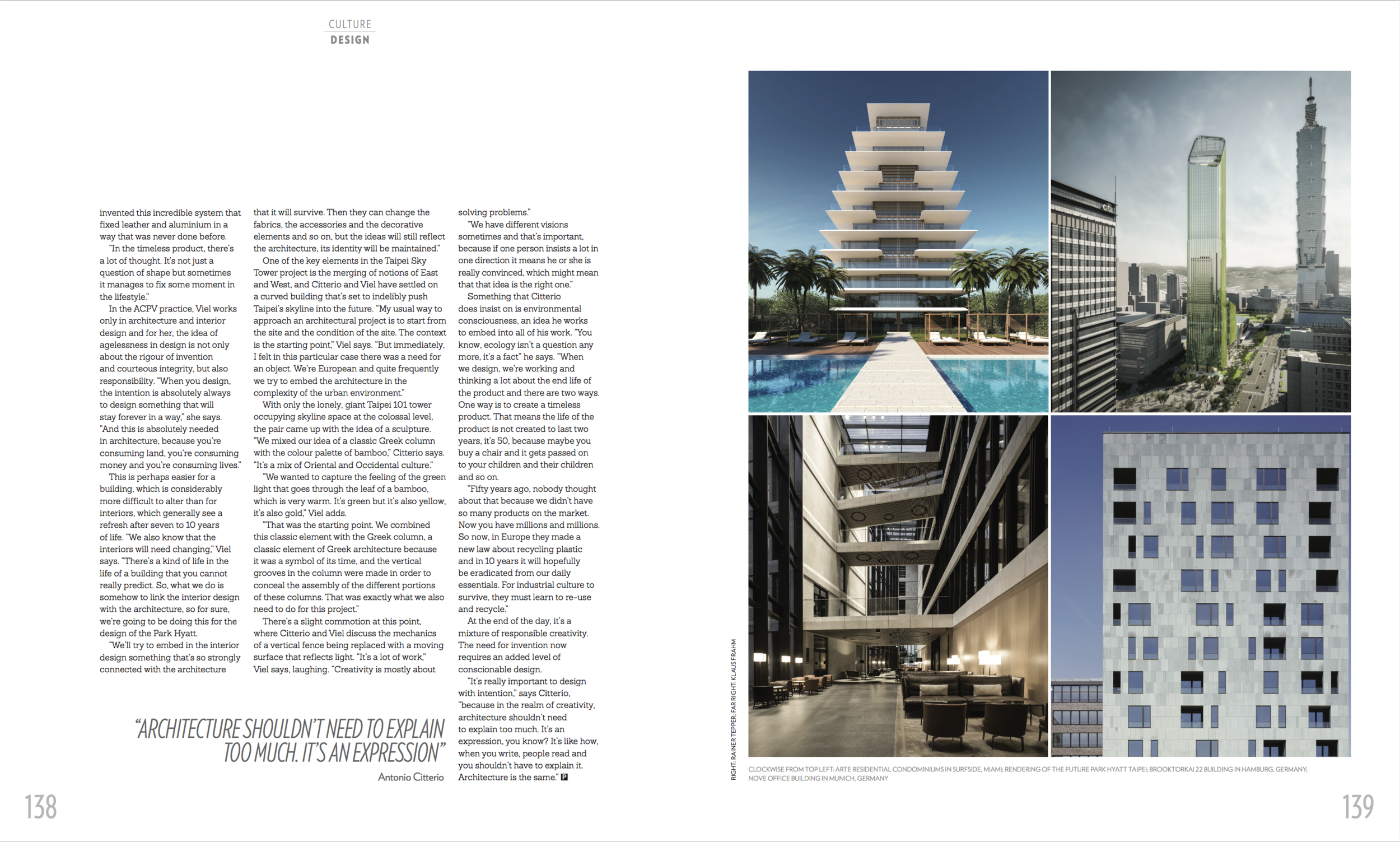Antonio Citterio & Patricia Viel (ACPV) | Prestige Hong Kong (Apr 18)
Antonio Citterio and Patricia Viel of design firm ACPV explain to zaneta cheng what a classic Milanese take on form and function means for design and modern behaviour
Antonio Citterio and Patricia Viel are giving me a lesson in good manners. The two designers, partners in architecture and design firm ACPV, are in front of me in Taipei, fresh off two consecutive flights from Milan, because they’ve been tasked with building Riant Capital’s Taipei Sky Tower, a 280-metre-tall, US$1-billion behemoth due to open in 2020. The building will house two hotels – the Taipei Andaz and the Park Hyatt, the latter of which will also be designed by ACPV. The project is branded as Taiwan’s first “large-scale lifestyle-driven development” with hopes to put Taipei at the centre of Asia’s cultural conversation.
“Luxury is something that creates a very good environment for good behaviours,” Patricia Viel says. “It’s not something you really see as a luxury. It’s an experience. It’s a sensation.
“Good behaviours are not to speak too loud. You don’t need to occupy too much space with your things, with your friends, with your presence. To be clean, to be careful about other people that are with you. These are good behaviours.
“There are people who really don’t understand the kind of luxury environment that we design because we are, I mean, very quiet,” Viel continues. “We use beautiful materials but we like to stay very simple and somehow not too busy with the colour palette. So, it depends, right? You have people who need to be surprised, to be amused by what they see and they probably misunderstand the fact that they had fun with the idea of luxury.”
Antonio Citterio is widely recognised as the “gentleman” of design. Perhaps this insistence on polite design is part of it. When I suggest this, he says, “It’s very kind of them to say, but my approach from the beginning is, don’t look at what happens, don’t look at trends. Really work for normality.
“Do you know what I mean by normal? Normal means when you’re not looking for something extraordinary. You look for the quotidian but in the quotidian you really try to do something with a lot of synthesis – and you know when you get that you have a really good result. Like the man who designed the polo [shirt]. It is such a classic item, I am jealous of the person who invented the polo because it’s a fantastic element and many people have this object and this is exactly what I try to do in design.”
Citterio’s dedication to creating and achieving a quality of timelessness in his work eschews the rigmarole of fame and glory that many other designers relish, “What matters is the result. What the process is, is our intellectual exercise but in the end it’s a result” he says. “You spent five to six years in meetings, designing, flying here and there, meeting and speaking with journalists like you – so it must be a good result, otherwise, it’s a waste.”
But what is timelessness? And how does Citterio design for a quality that requires the proof of time. “Timelessness is not created in a second. I will be presenting the new office chair for Vitra next spring and it’s taken at least five years of constant improvement for me to finally have that chair.
“But take a look at the chair you’re sitting on. It’s a copy, but it was done by Eames in the ’50s – and why is it a timeless product? Because it’s an invention. He invented this incredible system that fixed leather and aluminium in a way that was never done before.
“In the timeless product, there’s a lot of thought. It’s not just a question of shape but sometimes it manages to fix some moment in the lifestyle.”
In the ACPV practice, Viel works only in architecture and interior design and for her, the idea of agelessness in design is not only about the rigour of invention and courteous integrity, but also responsibility. “When you design, the intention is absolutely always to design something that will stay forever in a way,” she says. “And this is absolutely needed in architecture, because you’re consuming land, you’re consuming money and you’re consuming lives.”
This is perhaps easier for a building, which is considerably more difficult to alter than for interiors, which generally see a refresh after seven to 10 years of life. “We also know that the interiors will need changing,” Viel says. “There’s a kind of life in the life of a building that you cannot really predict. So, what we do is somehow to link the interior design with the architecture, so for sure, we’re going to be doing this for the design of the Park Hyatt.
“We’ll try to embed in the interior design something that’s so strongly connected with the architecture that it will survive. Then they can change the fabrics, the accessories and the decorative elements and so on, but the ideas will still reflect the architecture, its identity will be maintained.”
One of the key elements in the Taipei Sky Tower project is the merging of notions of East and West, and Citterio and Viel have settled on a curved building that’s set to indelibly push Taipei’s skyline into the future. “My usual way to approach an architectural project is to start from the site and the condition of the site. The context is the starting point,” Viel says. “But immediately, I felt in this particular case there was a need for an object. We’re European and quite frequently we try to embed the architecture in the complexity of the urban environment.”
With only the lonely, giant Taipei 101 tower occupying skyline space at the colossal level, the pair came up with the idea of a sculpture. “We mixed our idea of a classic Greek column with the colour palette of bamboo,” Citterio says. “It’s a mix of Oriental and Occidental culture.”
“We wanted to capture the feeling of the green light that goes through the leaf of a bamboo, which is very warm. It’s green but it’s also yellow, it’s also gold,” Viel adds.
“That was the starting point. We combined this classic element with the Greek column, a classic element of Greek architecture because it was a symbol of its time, and the vertical grooves in the column were made in order to conceal the assembly of the different portions of these columns. That was exactly what we also need to do for this project.”
There’s a slight commotion at this point, where Citterio and Viel discuss the mechanics of a vertical fence being replaced with a moving surface that reflects light. “It’s a lot of work,” Viel says, laughing. “Creativity is mostly about solving problems.”
“We have different visions sometimes and that’s important, because if one person insists a lot in one direction it means he or she is really convinced, which might mean that that idea is the right one.”
Something that Citterio does insist on is environmental consciousness, an idea he works to embed into all of his work. “You know, ecology isn’t a question any more, it’s a fact” he says. “When we design, we’re working and thinking a lot about the end life of the product and there are two ways. One way is to create a timeless product. That means the life of the product is not created to last two years, it’s 50, because maybe you buy a chair and it gets passed on to your children and their children and so on.
“Fifty years ago, nobody thought about that because we didn’t have so many products on the market. Now you have millions and millions. So now, in Europe they made a new law about recycling plastic and in 10 years it will hopefully be eradicated from our daily essentials. For industrial culture to survive, they must learn to re-use and recycle.”
At the end of the day, it’s a mixture of responsible creativity. The need for invention now requires an added level of conscionable design.
“It’s really important to design with intention,” says Citterio, “because in the realm of creativity, architecture shouldn’t need to explain too much. It’s an expression, you know? It’s like how, when you write, people read and you shouldn’t have to explain it. Architecture is the same.”

